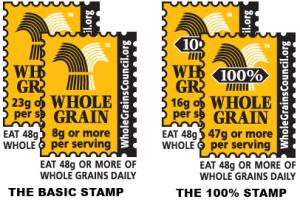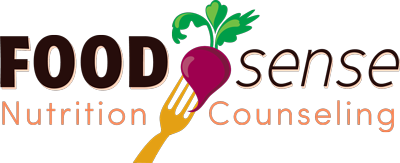Decoding Whole Grains
 Decoding whole grains
Decoding whole grains
It’s National Whole Gain month, if you didn’t know already (but of course you did, right?). This month’s blog post comes to us by former dietetic intern Katherine Doughty, MS, IBCLC. Choosing whole grains can be confusing at times, but read along to understand more about the benefits of whole grains and how to know if the product you are buying is whole grain or refined.
Multigrain, whole wheat, wheat, 12 grain, honey wheat, white wheat, 100% whole grain—what does it all mean? How does one know if something is a whole grain? Does it even matter if it is a whole grain?
To figure this out, let’s start with an explanation of whole grains. A grain has three parts: the bran, the endosperm and the germ. The outermost layer, the bran, is full of fiber, energy producing B vitamins, trace minerals and phytochemicals. The endosperm is composed of carbohydrates and protein. The innermost layer, the germ, includes B vitamins, Vitamin E, trace minerals, phytochemical and unsaturated fats (1). In it’s whole form, this is what we call a “whole” grain. Often times these once “whole” grains are refined in order to change their texture and improve their shelf life (2). The refinement process involves removing the bran and germ through grinding or selective shifting (3) and losing the nutrients within these layers. These grains may then be enriched by adding some B vitamins and iron back to the grain.
Whole grains can be divided into two categories, those which contain gluten and those which do not. Gluten free whole grains include: amaranth (also a complete protein), buckwheat, corn, millet (also high in antioxidants and magnesium), montina, oats*, quinoa, rice, sorghum, and teff (high in calcium). Those containing gluten include: barley, bulgur, einkorn, farro, kamut, semolina, triticale and wheat.(4)(5)
But how do you know if you are getting one of these nutrition packed whole grains or a refined grain? You can first look on the package for the Whole Grain Council’s stamp. This stamp has been around since 2005 and displays the amount of whole grains in the product.(6) There are other clues to look for in the ingredient list. If the word enriched precedes B vitamins such as riboflavin or thiamin, this likely indicates that the product has been refined to some degree; other hints that the food contains refined grains include the words degerminated and wheat germ. Multigrain is also a tricky one as it could mean that the food contains a mixture of whole grains or a mix of refined and whole grains. So what are some sure fire ways to identify whole grains? Look for ingredients like 100% whole wheat, stoneground whole wheat (or another grain), wheat berries or brown rice (7).
To learn more about whole grains including recipes check out:
http://wholegrainscouncil.org/
http://www.choosemyplate.gov/food-groups/grains.html
*Those with gluten allergies/sensitivities should take care when choosing foods containing oats as they may be subject to cross-con
(1) Whole Grain Cereal. Retrieved on 01/26/15 from: http://agcj.tamu.edu/407/sites/Sarvarian2/nutrition.htm
(2) Nancy Lapid (12/15/14). What Does “Whole Grain” Mean? Retrieved on 01/26/15 from: http://celiacdisease.about.com/od/celiacdiseasefaqs/f/WholeGrain.htm
(3) Refined grains (2/7/14). In Wikipedia, The Free Encyclopedia. Retrieved on 1/28/15 from: http://en.wikipedia.org/wiki/Refined_grains
(4) Whole Grain Council. Gluten Free Whole Grains. Retrieved on 01/26/15 from: http://wholegrainscouncil.org/whole-grains-101/gluten-free-whole-grains
(5) Whole Grain Council. Whole Grains A to Z. Retrieved on 01/26/15 from: http://wholegrainscouncil.org/whole-grains-101/whole-grains-a-to-z
(6) Whole Grain Council. Stamp FAQ-Consumers. Retrieved on 01/26/15 from: http://wholegrainscouncil.org/whole-grain-stamp/stamp-faq-consumers
(7) Whole Grain Council. Identifying Whole Grain Products. Retrieved on 01/26/15 from: http://wholegrainscouncil.org/whole-grains-101/identifying-whole-grain-products
